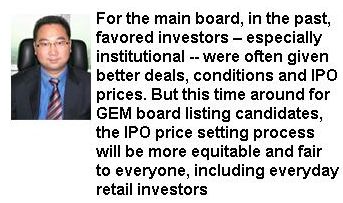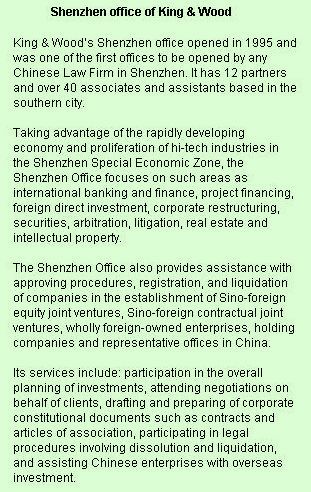 Mr Cao specialises in corporate finance, M&A and foreign direct investment.
Mr Cao specialises in corporate finance, M&A and foreign direct investment.
CHINA RECENTLY UNVEILED plans to launch a long-delayed Nasdaq-style trading board in the southern city of Shenzhen to help raise capital for small and medium-sized enterprises (SMEs).
* an operating history of at least three years;
* net assets of at least 20 mln yuan;
* been in the black in each of the past two years with a combined profit of at least 10 mln yuan.
The listing requirements for the new board are less stringent than the requirements for listing on China’s main bourses – home of the mighty A-shares -- which require a track record of three years’ profits of at least 30 mln yuan.
But behind all these dry figures … what hurdles and potential rewards is an aspiring counter on the new board confronting in the run-up to the anticipated Chinese Oct 1 National Day launch?
The verdict from China’s largest law firm
Mr. Cao Yuhui, partner at King & Wood Law Firm for the past two years, specializes in corporate finance, mergers & acquisitions and foreign direct investment. He has represented several large domestic companies in their initial public offers in China and many domestic companies in their overseas IPOs, private placement and M&As.
Mr. Cao also has provided legal services to foreign investors in their FDIs, venture capital investments and M&As in China, and also has in-depth knowledge and extensive practice experience in the sectors of hi-tech, IT and infrastructure.
Therefore, he has lots of useful insights into what exactly is confronting GEM listco wannabes.
In an exclusive interview with NextInsight, Mr. Cao said King & Wood would be working with several aspirees to the new board. “We will definitely be doing legal work for companies planning to list on the GEM board. We are working out plans for that now. My office works particularly closely with a lot of SMEs in Guangdong province and across southern China,” he said.
China’s new second board will not be so demanding on potential listees as the existing bourse regimes.
“Most companies will likely be able to begin share issues on the GEM board around one month after getting approval from the CSRC. As the current regulations stand, it is more difficult for foreign investment firms to participate in the GEM board listing processes compared with domestic Chinese counterparts,” Mr. Cao added.
However, the gauntlet run to GEM board listing will not fully resemble that for the A-share markets.
“In the past, there was an approval process, road show, and IPO price determining exercise. But for this new GEM board, things will be slightly different. For the main board, in the past, favored investors – especially institutional -- were often given better deals, conditions and IPO prices. But this time around for GEM board listing candidates, the IPO price setting process will be more equitable and fair to everyone, including retail investors,” Mr. Cao said.
As for access to foreign clients hoping to take part, traditionally it’s been a problem of them “not having any local clients to vouch for them,” and also a matter of not knowing the market or how business is actually carried out in China, he said.
“If you are, for example, a typical normal investor in Hong Kong, or outside of China, they have little opportunity to take part at this point. One way to participate is to get official status and authorization as a QFII. Another is to become a strategic investor, and form such a partnership with the target firm. And among these, the foreign firms can choose to become a pre-IPO strategic investor, or post-placement strategic investor.”

King & Wood is one of the largest law firms in China, with over 800 lawyers, patent attorneys, and legal professionals.
Another surefire way for foreign enterprises to become involved is by becoming long-term investors, wherein they pledge to not sell shares for a period of three years.
“This is another way into the market for them,” he said. “So overall, the ongoing IPO and share issue reforms at the CSRC are more targeted toward domestic investors, with rules regulating foreign investors moving forward more slowly. But it is only natural that typical P/E investors, strategic investors, and long-term investors would be treated differently from a regulatory standpoint.”
He said most domestic firms looking to list on the GEM will likely look to domestic IR and PR firms to help them.
“And they will rely more on IR and PR firms to boost interest and visibility for their firm rather than direct media exposure prior to their proposed GEM listings.”
When asked what in particular about listing candidates for the GEM attracts him and makes King & Wood want to work with them, he said management proficiency was key.
“If we like their management and also if we like some of the projects they are proposing, we will look into it. For this we don’t discriminate on whether it’s domestic of offshore. As for their listing candidacy, we assess how feasible it is, and also how feasible their proposed partnerships are, and we try to bring both sides together and work out the kinks.
“Of course, we can also play the role of the financial consultant, especially among the very stressful and trying run-up to a planned listing.”
He said PR/IR companies also play an important role at this stage and beyond.
“If done effectively, this can all hopefully lead to an even higher-than-expected IPO price for the listing candidate.”
He said his law firm took a particular interest in consumer goods firms -- especially foodstuffs. When asked to compare the number of hoops that A-share and GEM board hopefuls were expected to jump through, he said the similarity ended at the capital requirements.
“Both must exist for three years before application to the bourses, but actually of all the firms I know of looking to list on GEM have already met the basic requirements of the main (A) board… maybe around 90%.”
But he said that the vast bulk will choose the GEM for their initial listing, because they don’t want to wait in a “long cue” for an A-board sighting.
“There’s a big line to get on the (A-share) mainboard. So for the first group of GEM candidates, I think 90% or maybe more of them could qualify for the A-board. For the first group of GEM listees, there should be around 50-60 companies approved… this is quite a few, even more that the first batch of A-board listees way back when.”
Mr. Cao obtained his B.A .and M.A. from Central South University, and studied at the School of Oriental and African Studies, University of London on Lord Chancellor's Young Lawyers' Training Scheme. He was admitted as a Chinese lawyer in 1995. He is proficient in Chinese, English and Japanese.
First article in the series: Countdown to China’s Growth Enterprise Market (GEM) board launch


